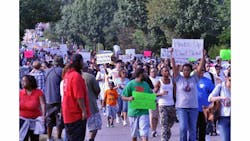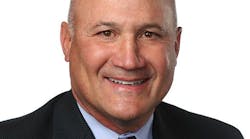Missouri Governor Jay Nixon on Tuesday outlined preparations that are currently underway by authorities in the state to provide security for more protests that are expected to follow a grand jury’s decision later this month on whether or not to indict the Ferguson, Mo. police officer who shot and killed an unarmed black teenager earlier this summer. The shooting sparked weeks of protests in Ferguson, a St. Louis suburb, some of which turned violent.
Last week during the Secured Cities conference in Baltimore, Md., Lt. Les Thurston, assistant director of the Missouri State Highway Patrol’s Information and Communications Technology Division, discussed how state troopers were able to effectively respond to the protests through a combination of advanced security and communications equipment. Immediately after the protests started in Ferguson, the state patrol deployed its mobile command and communications vehicle (MCCV) to the area, which Thurston helps oversee.
According to Thurston, the MCCV, affectionately referred to as “Big Blue,” is equipped with Cisco’s IPICS (IP Interoperability and Collaboration System) technology that enables the state patrol to integrate communications from various law enforcement and first responder agencies through the MCCV’s dispatch center. IPICS played a prominent role in law enforcement operations during the Ferguson protests as it provided a way to patch all of the communications coming in from the various agencies involved through the MCCV.
Despite having this technology, however, Thurston said that it wouldn’t have done them any good had they not established partnerships with local police and other agencies in advance of the protests. “If we had not developed partnerships with these agencies ahead of time it would have been too late,” Thurston told attendees at the show.
Thurston said that the MCCV also played a pivotal role during recovery efforts in the town of Joplin, which was struck by a devastating tornado in May 2011 that killed more than 150 people and wiped out most of the city’s infrastructure, including the hospital. By using the IPICS solution on the truck, Thurston said they were able to restore communications and get cellphones back up and running until repairs could be made in the city.
In addition to IPICS, the MCCV is also outfitted with a camera mounted on a 40-foot boom arm which helped authorities inside the vehicle see where protesters were moving and allowed them to predict where the flow of people would be concentrated next. “That’s real-time information that we can provide and that’s valuable,” Thurston added.
However, Thurston said that “Big Blue” also became a target during the protests as the MCCV experienced its’ first real cyber threat. Thurston said that people were attempting to try and spoof communications from the vehicle at several times during the protests.
Thurston warned attendees at the conference from the law enforcement community that they need to place an increased emphasis on securing their communications. “Your communications are targets greater than you ever thought,” he said. “There are groups trying to intercept your communications.”
The MCCV is also able to support onboard video and telecommunication conferences, which provided authorities with a way to quickly communicate with the governor throughout the protests and thereby allowed him to relay what steps he wanted to take next.
While many have criticized law enforcement’s initial response to the protests and raised questions about the “militarization” of police departments across the country, Thurston says officers and troopers that were working in that area were doing the best they could do to contain the situation and keep the protests from turning violent. “Regardless of what you see in the news… there are a lot of good people out there doing good things every day,” he said.
Thurston said he expects to be back in Ferguson to deal with what may come in the wake of the grand jury’s decision and that they are already taking steps to prepare. “My greatest fear going from here is it will be an event that happens outside of just Ferguson,” concluded Thurston. “I know this issue in St. Louis isn’t over, but it can happen anywhere.”


